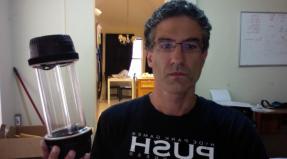Acyclovir-akrikhin ointment - instructions for use. Acyclovir-Acrichin ointment - instructions for use
Registration number: R N000241/02
Trade name of the drug: Acyclovir-Akrikhin
international generic name: acyclovir
Dosage form: ointment for external use
Composition: 100 g of ointment contains:
active substance: acyclovir in terms of 100% substance - 5 g;
Excipients: propylene glycol - 40 g, vaseline - 12.5 g, vaseline oil - 7.5 g, emulsion wax - 5 g, macrogol (polyethylene oxide 1500) - 1 g, purified water - up to 100 g.
Description: ointment white or almost white. A characteristic odor is allowed.
Pharmacotherapeutic group: antiviral agent for local application
ATX code: D06BB03
Pharmacological properties
Pharmacodynamics
Antiviral drug is a synthetic analogue of thymidine nucleoside.
In infected cells containing viral thymidine kinase, phosphorylation occurs and is converted to acippovir monophosphate. Under the influence of guanylate cyclase, acippovir monophosphate is converted to diphosphate and, under the action of several cellular enzymes, to triphosphate.
The high selectivity of action and low toxicity to humans are due to the lack of the necessary enzyme for the formation of acyclovir triphosphate in intact cells of the macroorganism.
Acyclovir triphosphate, "embedding" in the DNA synthesized by the virus, blocks the reproduction of the virus. The specificity and very high selectivity of action are also due to its predominant accumulation in cells affected by the herpes virus. Highly active against Herpes simplex virus types 1 and 2; the virus that causes chicken pox and shingles (Varicella zoster); Epstein-Barr virus. Moderately active against cytomegaloviruses.
Pharmacokinetics
When applied to intact skin: absorption is minimal; not detected in blood and urine. On the affected skin: moderate absorption; in patients with normal renal function, the concentration in blood serum is up to 0.28 μg / ml, in patients with chronic kidney failure(CRF) - up to 0.78 mcg / ml. Excreted by the kidneys (up to 9.4% daily dose).
Indications for use
Skin infections caused by Herpes simplex virus types 1 and 2, genital herpes, shingles, chicken pox.
Contraindications
Hypersensitivity to acyclovir and other components of the drug.
Carefully- pregnancy, lactation, dehydration, renal failure.
Pregnancy and lactation
The use of the drug is indicated only in cases where the intended benefit to the mother outweighs the potential risk to the fetus. During the period of treatment, it is necessary to resolve the issue of stopping breastfeeding.
Dosage and administration
Outwardly. The drug is applied with clean hands or with a cotton swab 5 times a day (every 4 hours) in a thin layer on the affected and adjacent areas of the skin.
Therapy should be continued until the blisters form a crust, or until they are completely healed. The duration of therapy is an average of 5 days, a maximum of 10 days. If there is no effect, you should consult a doctor.
Side effect
Hyperemia, dryness, peeling of the skin; burning, inflammation in contact with mucous membranes. Possible development allergic dermatitis.
Interaction with others medicines
When applied externally, no interactions with other drugs have been identified. Strengthening the effect is noted with the simultaneous appointment of immunostimulants.
special instructions
To achieve maximum therapeutic effect it is necessary to use the drug as early as possible (at the first signs of the disease: burning, itching, tingling, feeling of tension and redness).
The ointment is not recommended to be applied to the mucous membranes of the oral cavity and eyes, since the development of severe local inflammation is possible.
In the treatment of genital herpes, sexual intercourse should be avoided or condoms should be used, since the use of acyclovir does not prevent the transmission of the virus to partners.
Pharmacodynamics
Acyclovir-Akrikhin - an antiviral agent; is a synthetic analogue of the acyclic purine nucleoside, which is highly selective against herpes viruses.
The mechanism of action of the drug is as follows: acyclovir, which penetrates into infected cells containing viral thymidine kinase, is phosphorylated and converted to acyclovir monophosphate. Then, under the influence of the enzyme guanylate cyclase, acyclovir monophosphate is converted into diphosphate and then (under the influence of a number of cell enzymes) into triphosphate.
After that, acyclovir triphosphate begins to integrate into the DNA of the virus and blocks its synthesis due to competitive inhibition of the DNA polymerase of the viral cell. High selectivity of action and specificity are also due to the fact that acyclovir accumulates mainly in cells affected by herpes infection.
Acyclovir-Akrikhin is highly active against Varicella zoster (the virus that causes shingles and chickenpox), Herpes simplex types 1 and 2, and human herpes virus type 4 (Epstein-Barr virus). Acyclovir has moderate activity against cytomegalovirus.
With herpes, Acyclovir-Akrikhin helps prevent the appearance of new elements of the rash, reduces the risk of damage internal organs and skin dissemination, reduces pain in the acute phase of herpes zoster, accelerates the formation of crusts.
Pharmacokinetics
The bioavailability of acyclovir at oral administration ranges from 15 to 30%. It penetrates well into all tissues and organs; in cerebrospinal fluid its concentration is 50% of plasma. Acyclovir passes through the placental and blood-brain barriers, penetrates into breast milk. From 9 to 33% of the active substance binds to plasma proteins.
The maximum plasma concentration of acyclovir after taking 200 mg of the drug 5 times a day is 0.7 μg / ml. It takes 1.5-2 hours to achieve this indicator.
Metabolism takes place in the liver. As a result, pharmacologically inactive 9-carboxymethoxymethylguanine is formed. When taken orally, the elimination half-life is 2-3 hours. In patients with severe renal insufficiency, it is extended to 20 hours, and in patients on hemodialysis - up to 5.7 hours (plasma concentration of acyclovir is reduced to 60% of the initial value).
Approximately 84% of the drug is excreted unchanged and approximately 14% in the form of a metabolite. The main route of excretion is through the kidneys; less than 2% of acyclovir is excreted in the feces; trace amounts were determined in exhaled air.
With external use of Acyclovir-Akrikhin (in the form of an ointment), the absorption of acyclovir on intact skin areas is minimal; it is not detected in urine and blood. If the skin is affected, then absorption is moderate. Serum concentration of acyclovir is up to 0.28 mcg / ml in persons with normal renal function and up to 0.78 mcg / ml in patients with chronic renal failure. Up to 9.4% of the daily dose of the drug is excreted in the urine (through the kidneys).
The antiviral drug is a synthetic analog of the thymidine nucleoside. In infected cells containing viral thymidine kinase, phosphorylation and conversion to acyclovir monophosphate occurs. Under the influence of acyclovir guanylate cyclase, monophosphate is converted to diphosphate and, under the action of several cellular enzymes, to triphosphate.
How is this the best medicine?
Notify all your suppliers medical services that you are taking acyclovir ointment. Talk to your doctor before using other drugs or products on your skin. If you have genital herpes, this medicine will not stop it from spreading. Do not have sex if you have sores or other signs of genital herpes. Genital herpes can also spread if you don't have any symptoms. Do not have sex without using a latex or polyurethane condom. Tell your doctor if you are pregnant or plan to become pregnant. You will need to talk about the benefits and risks of using aciclovir ointment during pregnancy. Tell your doctor if you are breastfeeding. You will need to talk about any risks to your child.
- This includes your doctors, nurses, pharmacists and dentists.
- This medicine is not a cure for herpes infection.
- Talk to your doctor.
Use this medicine as directed by your doctor.
Acyclovir triphosphate, integrating into the DNA synthesized by the virus, blocks the reproduction of the virus. The specificity and very high selectivity of action are also due to its predominant accumulation in cells affected by the herpes virus. Highly active towards
herpes simplex virus types 1 and 2; the virus that causes varicella and shingles (Varicella zoster); Epstein-Barr virus. moderately active
for cytomegaloviruses.
What are some side effects that I need to call my doctor right away?
Read all the information provided to you. Follow all instructions carefully. Be sure to dry. Apply a thin layer to the affected skin and rub in gently. Use a rubber glove to apply the ointment. This helps prevent the spread of infection. If it's close to the time for your next dose, skip the missed dose and go back to your usual time.
- Use as you were told, even if your symptoms improve.
- Do not take acyclovir ointment by mouth.
- Keep out of mouth, nose and eyes.
- Wash your hands before and after use.
- Clean the affected part before use.
- Put down the missed dose as soon as you think about it.
- Do not apply 2 doses or additional doses.
Tell your doctor or seek immediate
medical care
If you have any of
the following signs
or symptoms that may be associated with a very bad side effect.
When is it appointed?
Acyclovir is active against the herpes virus, so the ointment is prescribed for external use for infectious lesions of the skin and mucous membranes (lips are especially susceptible to infection). Active ingredient The drug penetrates into the changed structure of the skin at the cellular level and destroys the virus, blocking its activity and spread. Indications for the use of the ointment "Acyclovir-akrikhin" are:
- infectious diseases of the skin and mucous membranes resulting from infection with the herpes virus (types 1 and 2);
- genital herpes;
- chickenpox;
- shingles type.
"Acyclovir-acriquine" refers to antiviral agents and is used to treat infectious skin lesions caused by the herpes virus (Herpes simplex) types 1 and 2. Active substance the drug - acyclovir - is practically not absorbed by the mucous membranes and is not detected in the blood serum and urine. This applies to the case when the ointment was applied to intact (intact) skin. If the treatment was carried out on damaged areas, a moderate concentration of the active ingredient is determined in liquid structures.
Release form and composition
Ointment "Acyclovir-akrikhin" is available in aluminum tubes with a volume of 2 g, 3 g and 5 g. The drug has a uniform dense white texture with a characteristic odor.
The amount of acyclovir in 100 g of ointment is 5 g, so the ointment has a 5% concentration.
In addition to acyclovir, excipients are used in the production of the drug "Acyclovir-Akrikhin":
- vaseline and vaseline oil (for consistency);
- emulsion wax;
- propylene glycol;
- macrogol;
- water of special treatment.
The presence of excipients should be considered in patients with various forms allergies (including medicinal).
When is it appointed?
Acyclovir is active against the herpes virus, so the ointment is prescribed for external use for infectious lesions of the skin and mucous membranes (lips are especially susceptible to infection). The active component of the drug penetrates into the changed structure of the skin at the cellular level and destroys the virus, blocking its activity and spread. Indications for the use of the ointment "Acyclovir-akrikhin" are:
- infectious diseases of the skin and mucous membranes resulting from infection with the herpes virus (types 1 and 2);
- genital herpes;
- chickenpox;
- shingles type.
Important! It is impossible to allow the agent to enter the mouth, therefore "Acyclovir-Akrikhin" is not suitable for the treatment of ulcers on the mucous membranes oral cavity.
How to apply?
Instructions for use of the ointment recommends applying the product with your hands or with a cotton pad. If cotton wool is used for processing, it is better to purchase special sterile cotton balls. If the ointment is applied by hand, it is important to wash them with antibacterial soap before starting the procedure. You can additionally treat the skin with an antiseptic solution (for example, "Chlorhexidine"). This is to prevent dirt and bacteria from getting into the vesicles and blisters and preventing a secondary infection from developing.
Ointment "Acyclovir-akrikhin" is used for local treatment of the affected skin (only externally) in the following way:
- apply a small amount of the product to the affected area;
- distribute the drug over the entire infected surface with a thin layer;
- treatment should be carried out 5 times a day every 4 hours (excluding the time of night sleep).
The duration of treatment is 5-10 days. It is necessary to use the ointment until the bubbles dry up (crust) or disappear completely.
Important! If therapy does not give a positive result, it is urgent to consult a doctor and undergo a comprehensive examination.
When not to apply?
Ointment "Acyclovir-akrikhin" when used locally is practically not absorbed into the blood, therefore this method use has no contraindications for use, except in cases of hypersensitivity or intolerance to the active substance / additional ingredients of the drug.
Increased caution should be exercised when prescribing the drug to patients who have the following conditions:
- pregnancy;
- dehydration of the body;
- the period of breastfeeding;
- renal failure of chronic and acute type.
special instructions
- It is necessary to start treatment with Acyclovir-acry ointment when the first symptoms of the disease appear. With a prolonged course, a decrease in the effectiveness of the drug is possible.
- With genital herpes, condoms should be used for the entire period of treatment to prevent infection of the partner. The best way- to refuse sexual intimacy completely until a full recovery occurs.
- Treatment with drugs based on acyclovir should be accompanied by sufficient consumption of clean water.
- Do not allow the product to enter the mouth and eyes. Contact of acyclovir with thin mucous membranes of the mouth and eyes can cause severe local inflammation.
Side effects
"Acyclovir-acry" when used externally can cause adverse reactions and allergies. Most often, patients experience:
- allergic dermatitis;
- burning;
- severe itching;
- peeling of the skin;
- inflammatory reactions upon contact with mucous membranes (for example, when the agent enters the mouth).
In some cases, a slight increase in temperature is possible. If the thermometer does not exceed 38 degrees, you do not need to take antipyretics and seek help from the hospital.
If the ointment gets into your mouth
Despite the fact that the instructions recommend avoiding getting the ointment in your mouth. Sometimes it happens that one careless movement leads to the fact that a small amount of the drug is in the oral cavity. What to do in this case? The answer is nothing. If a small amount of ointment gets into the mouth (it is impossible not to notice, since the remedy has a very bitter taste), and after a while the patient has no signs of inflammation, no special measures are needed. It is often enough to rinse your mouth with water or chamomile decoction and increase the amount of fluid you drink.
It is necessary to consult a doctor in the following cases:
- bleeding wounds appeared on the mucous membrane of the oral cavity;
- a burning sensation appeared in the mouth, which does not disappear after copious rinsing with water;
- sections of the mucosa became inflamed and painful (it hurts to open your mouth, drink, talk).
Ointment "Acyclovir-akrikhin" - effective remedy for the treatment of herpes, which has been used for several decades. Subject to compliance with safety measures, the use of the drug does not cause discomfort and does not cause side effects, therefore, the drug belongs to the group of drugs of choice for the elimination of herpetic lesions in various categories of patients.
Active substance
Aciclovir (aciclovir)
Release form, composition and packaging
◊ Ointment for external use 5% white or almost white; characteristic odor is allowed.
Excipients: propylene glycol - 40 g, vaseline - 12.5 g, - 7.5 g, emulsion wax - 5 g, macrogol (polyethylene oxide 1500) - 1 g, purified water - up to 100 g.
2 g - aluminum tubes (1) - packs of cardboard.
3 g - aluminum tubes (1) - packs of cardboard.
5 g - aluminum tubes (1) - packs of cardboard.
pharmachologic effect
The antiviral drug is a synthetic analog of the thymidine nucleoside. In infected cells containing viral thymidine kinase, phosphorylation and conversion to monophosphate occurs. Under the influence of acyclovir guanylate cyclase, monophosphate is converted to diphosphate and, under the action of several cellular enzymes, to triphosphate. The high selectivity of action and low toxicity to humans are due to the lack of the necessary enzyme for the formation of acyclovir triphosphate in intact cells of the macroorganism.
Acyclovir triphosphate, integrating into the DNA synthesized by the virus, blocks the reproduction of the virus. The specificity and very high selectivity of action are also due to its predominant accumulation in cells affected by the herpes virus. Highly active towards herpes simplex virus types 1 and 2; the virus that causes varicella and (Varicella zoster); Epstein-Barr virus. moderately active for cytomegaloviruses.
Pharmacokinetics
When applied to intact skin, absorption is minimal; not detected in blood and urine. On the affected skin - absorption is moderate; in patients with normal renal function, the concentration in blood serum is up to 0.28 mcg / ml, in patients with chronic kidney disease (CRF) - up to 0.78 mcg / ml. Excreted by the kidneys (up to 9.4% of the daily dose).
Indications
- skin infections caused by the Herpes simplex virus types 1 and 2;
- shingles;
- chickenpox.
Contraindications
- hypersensitivity to acyclovir and other components of the drug.
FROM caution the drug should be used for dehydration, renal failure, pregnancy, lactation.
Dosage
Apply externally. The drug is applied with clean hands or with a cotton swab 5 times / day (every 4 hours) with a thin layer on the affected and adjacent areas of the skin.
Therapy should be continued until the blisters form a crust, or until they are completely healed. The duration of therapy is an average of 5 days, a maximum of 10 days.
If there is no effect, you should consult a doctor.
Side effects
From the skin and subcutaneous tissues: hyperemia, dryness, peeling of the skin.
Others: burning, inflammation in contact with mucous membranes. Development is possible.
Overdose
Data on drug overdose are not provided.
drug interaction
When applied externally, no interactions with other drugs have been identified.
Strengthening the effect is noted with the simultaneous appointment of immunostimulants.
special instructions
To achieve the maximum therapeutic effect, it is necessary to use the drug as early as possible (at the first signs of the disease: burning, itching, tingling, feeling of tension and redness).
In the treatment of genital herpes, sexual intercourse should be avoided or condoms should be used, because. the use of acyclovir does not prevent the transmission of the virus to partners.
Pregnancy and lactation
The use of the drug is indicated only in cases where the intended benefit to the mother outweighs the potential risk to the fetus.
During the period of treatment, it is necessary to resolve the issue of stopping breastfeeding.
For impaired renal function
Use with caution in renal failure.
Terms of dispensing from pharmacies
The drug is approved for use as a means of OTC.
Terms and conditions of storage
The drug should be stored out of the reach of children, dry, dark place, at a temperature not exceeding 25 ° C. Shelf life - 3 years. Do not use the drug after the expiration date.
Catad_pgroup Antivirals for herpes
Acyclovir-Akrikhin ointment - instructions for use
Registration number:
R N000241/02Trade name of the drug:
Acyclovir-AkrikhinInternational non-proprietary name:
acyclovirDosage form:
ointment for external useComposition:
100 g of ointment contains:active substance: acyclovir in terms of 100% substance - 5 g;
Excipients: propylene glycol - 40 g, vaseline - 12.5 g, vaseline oil - 7.5 g, emulsion wax - 5 g, macrogol (polyethylene oxide 1500) - 1 g, purified water - up to 100 g.
Description:
ointment white or almost white. A characteristic odor is allowed.
Pharmacotherapeutic group:
topical antiviral agentATX Code: D06BB03
Pharmacological properties
Pharmacodynamics
The antiviral drug is a synthetic analog of the thymidine nucleoside.
In infected cells containing viral thymidine kinase, phosphorylation occurs and is converted to acippovir monophosphate. Under the influence of guanylate cyclase, acippovir monophosphate is converted to diphosphate and, under the action of several cellular enzymes, to triphosphate.
The high selectivity of action and low toxicity to humans are due to the lack of the necessary enzyme for the formation of acyclovir triphosphate in intact cells of the macroorganism.
Acyclovir triphosphate, "embedding" in the DNA synthesized by the virus, blocks the reproduction of the virus. The specificity and very high selectivity of action are also due to its predominant accumulation in cells affected by the herpes virus. Highly active against Herpes simplex virus types 1 and 2; the virus that causes varicella and shingles (Varicella zoster); Epstein-Barr virus. Moderately active against cytomegaloviruses.
Pharmacokinetics
When applied to intact skin: absorption is minimal; not detected in blood and urine. On the affected skin: moderate absorption; in patients with normal renal function, the concentration in blood serum is up to 0.28 mcg / ml, in patients with chronic renal failure (CRF) - up to 0.78 mcg / ml. Excreted by the kidneys (up to 9.4% of the daily dose).
Indications for use
Skin infections caused by Herpes simplex virus types 1 and 2, genital herpes, shingles, chicken pox.
Contraindications
Hypersensitivity to acyclovir and other components of the drug.Carefully- pregnancy, lactation, dehydration, renal failure.
Pregnancy and lactation
The use of the drug is indicated only in cases where the intended benefit to the mother outweighs the potential risk to the fetus. During the period of treatment, it is necessary to resolve the issue of stopping breastfeeding.Dosage and administration
Outwardly. The drug is applied with clean hands or with a cotton swab 5 times a day (every 4 hours) in a thin layer on the affected and adjacent areas of the skin.Therapy should be continued until the blisters form a crust, or until they are completely healed. The duration of therapy is an average of 5 days, a maximum of 10 days. If there is no effect, you should consult a doctor.
Side effect
Hyperemia, dryness, peeling of the skin; burning, inflammation in contact with mucous membranes. Perhaps the development of allergic dermatitis.Interaction with other drugs
When applied externally, no interactions with other drugs have been identified. Strengthening the effect is noted with the simultaneous appointment of immunostimulants.
special instructions
To achieve the maximum therapeutic effect, it is necessary to use the drug as early as possible (at the first signs of the disease: burning, itching, tingling, feeling of tension and redness).
The ointment is not recommended to be applied to the mucous membranes of the oral cavity and eyes, since the development of severe local inflammation is possible.
In the treatment of genital herpes, sexual intercourse should be avoided or condoms should be used, since the use of acyclovir does not prevent the transmission of the virus to partners.
Release form
Read also...
- The history of the invention and development of watches The history of the transformation of watches
- Why does a person move and what are convulsions?
- How to decorate the room in an original way for the holiday: do-it-yourself birthday posters
- What are synonyms and antonyms in Russian What are called antonyms give examples



















